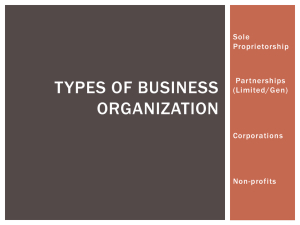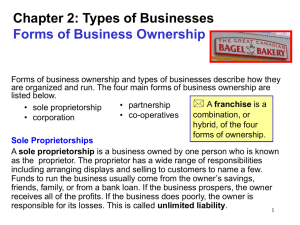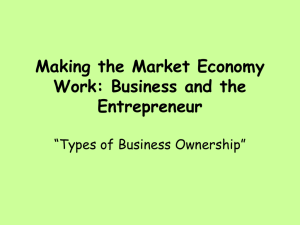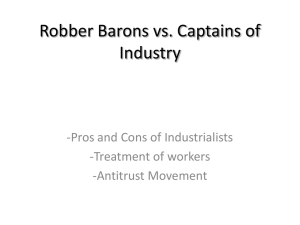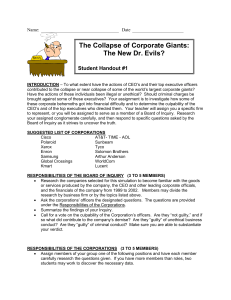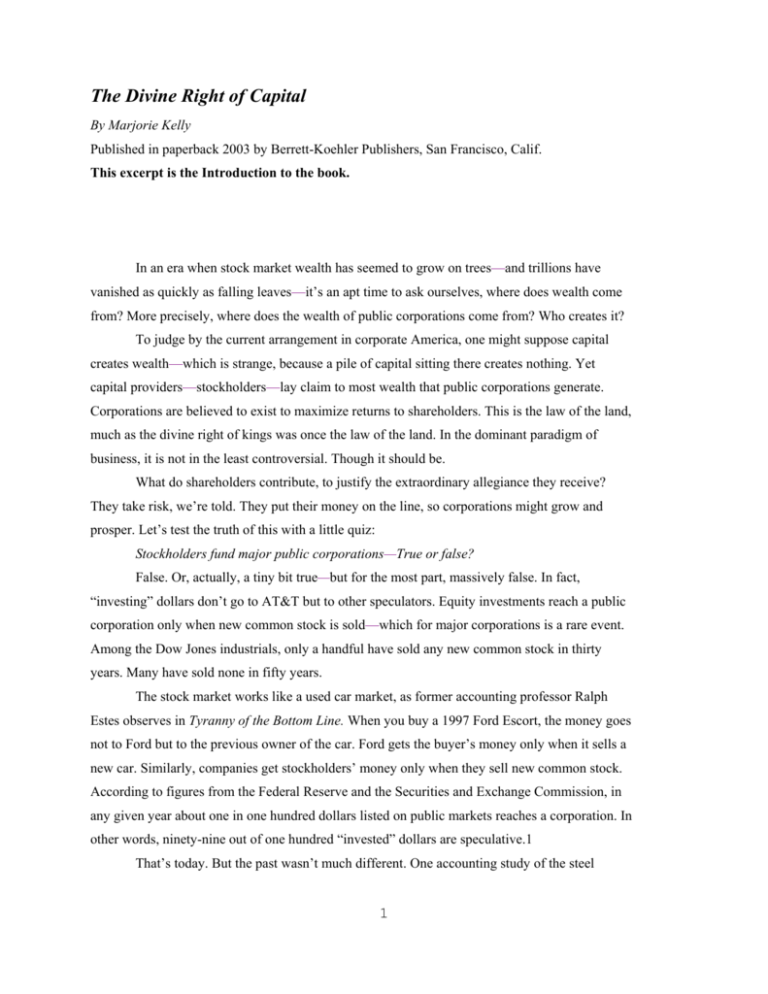
The Divine Right of Capital
By Marjorie Kelly
Published in paperback 2003 by Berrett-Koehler Publishers, San Francisco, Calif.
This excerpt is the Introduction to the book.
In an era when stock market wealth has seemed to grow on trees—and trillions have
vanished as quickly as falling leaves—it’s an apt time to ask ourselves, where does wealth come
from? More precisely, where does the wealth of public corporations come from? Who creates it?
To judge by the current arrangement in corporate America, one might suppose capital
creates wealth—which is strange, because a pile of capital sitting there creates nothing. Yet
capital providers—stockholders—lay claim to most wealth that public corporations generate.
Corporations are believed to exist to maximize returns to shareholders. This is the law of the land,
much as the divine right of kings was once the law of the land. In the dominant paradigm of
business, it is not in the least controversial. Though it should be.
What do shareholders contribute, to justify the extraordinary allegiance they receive?
They take risk, we’re told. They put their money on the line, so corporations might grow and
prosper. Let’s test the truth of this with a little quiz:
Stockholders fund major public corporations—True or false?
False. Or, actually, a tiny bit true—but for the most part, massively false. In fact,
“investing” dollars don’t go to AT&T but to other speculators. Equity investments reach a public
corporation only when new common stock is sold—which for major corporations is a rare event.
Among the Dow Jones industrials, only a handful have sold any new common stock in thirty
years. Many have sold none in fifty years.
The stock market works like a used car market, as former accounting professor Ralph
Estes observes in Tyranny of the Bottom Line. When you buy a 1997 Ford Escort, the money goes
not to Ford but to the previous owner of the car. Ford gets the buyer’s money only when it sells a
new car. Similarly, companies get stockholders’ money only when they sell new common stock.
According to figures from the Federal Reserve and the Securities and Exchange Commission, in
any given year about one in one hundred dollars listed on public markets reaches a corporation. In
other words, ninety-nine out of one hundred “invested” dollars are speculative.1
That’s today. But the past wasn’t much different. One accounting study of the steel
1
industry examined capital expenditures over the entire first half of the twentieth century and
found that issues of common stock provided only 5 percent of capital.2
So what do stockholders contribute, to justify the extraordinary allegiance they receive?
Very little. Yet this tiny contribution allows them essentially to install a pipeline and dictate that
the corporation’s sole purpose is to funnel wealth into it.
The productive risk in building businesses is borne by entrepreneurs and their initial
venture investors, who do contribute real investing dollars, to create real wealth. Those who buy
stock at sixth or seventh hand, or one-thousandth hand, also take a risk—but it is a risk
speculators take among themselves, trying to outwit one another, like gamblers. It has little to do
with corporations, except this: public companies are required to provide new chips for the gaming
table, into infinity.
*
*
*
It’s odd. And it’s connected to a second oddity—that we believe stockholders are the
corporation. When we say that a corporation did well, we mean that its shareholders did well. The
company’s local community might be devastated by plant closings. Employees might be
shouldering a crushing workload. Still we will say, “The corporation did well.”
One does not see rising employee income as a measure of corporate success. Indeed,
gains to employees are losses to the corporation. And this betrays an unconscious bias: that
employees are not really part of the corporation. They have no claim on wealth they create, no
say in governance, and no vote for the board of directors. They’re not citizens of corporate
society, but subjects.
We think of this as the natural law of the market. It’s more accurately the result of the
corporate governance structure, which violates market principles. In real markets, everyone
scrambles to get what they can, and they keep what they earn. In the construct of the corporation,
one group gets what another earns.
The oddity of it all is veiled by the incantation of a single, magical word: ownership.
Because we say stockholders own corporations, they are permitted to contribute very little, and
take quite a lot.
What an extraordinary word. One is tempted to recall the comment that Lycophron, an
ancient Greek philosopher, made during an early Athenian slave uprising against the aristocracy.
“The splendour of noble birth is imaginary,” he said, “and its prerogatives are based upon a mere
2
word.”3
*
*
*
A mere word. And yet the source of untold trouble. Why have the rich gotten richer while
employee income has stagnated? Because that’s the way the corporation is designed. Why are
companies demanding exemption from property taxes and cutting down three-hundred-year-old
forests? Because that’s the way the corporation is designed. “A rising tide lifts all boats,” the
saying goes. But the corporation functions more like a lock-and-dam operation, raising the water
level in one compartment by lowering it in another.
The problem is not the free market, but the design of the corporation. It’s important to
separate these two concepts we have been schooled to equate. In truth, the market is a relatively
innocent notion. It’s about buyers and sellers bargaining on equal footing to set prices. It might be
said that a free market means an unregulated one, but in today’s scheme it really means a market
with one primary form of regulation: that of property rights.
We think of this as inherent to capitalism, but it may not be. It is true that through history
capitalism has been a system that has largely served the interests of capital. But then, government
until the early twentieth century largely served the interests of kings. It wasn’t necessary to throw
out government in order to do away with monarchy—instead we changed the basis of sovereignty
on which government rested. We might do the same with the corporation, asserting that
employees and the community rightfully share economic sovereignty with capital owners.
What we have known until now is capitalism’s aristocratic form. But we can embrace a
new democratic vision of capitalism, not as a system for capital, but a system of capital—a
system in which all people are allowed to accumulate capital according to their productivity, and
in which the natural capital of the environment and community is preserved.
At the same time, we might also preserve much of the wisdom that is inherent in
capitalism. If we go rummaging through its entire basket of economic ideas—supply and demand,
competition, profit, self-interest, wealth creation, and so forth—we’ll find most concepts are
sturdy and healthy, well worth keeping. But we’ll also find one concept that is inconsistent with
the others. It is the lever that keeps the lock and dam functioning, and it is these four words:
maximizing returns to shareholders.
When we pluck this notion out of our basket and turn it over in our hands—really looking
at it, as we so rarely do—we will see it is out of place. In a competitive free market, it decrees
3
that the interests of one group will be systematically favored over others. In a system devoted to
unconscious regulation, it says corporations will consciously serve one group alone. In a system
rewarding hard work, it says members of that group will be served regardless of their
productivity.
Shareholder primacy is a form of entitlement. And entitlement has no place in a free
market. It is a form of privilege. And privilege accruing to property ownership is a remnant of the
aristocratic past.
*
*
*
That more people own stock today has not changed the market’s essentially aristocratic
bias. Of the total gain in marketable wealth from 1983 to 1998, more than half went to the richest
1 percent.4 Others of us may have gotten a few crumbs from this feast, but in their pursuit we are
too often led to work against our own interests. Physicians applaud when their portfolios rise in
value, yet wonder why insurance companies are ruthlessly holding down medical payments.
Employees cheer when their 401(k) plans post gains, yet wonder why layoffs are decimating their
firms. Their own portfolios hold the answer.
Still, decrying its ills is not the same as saying the stock market is devoid of value, nor
that it should be eliminated. The stock market does have its worthwhile functions. Stock serves as
a kind of currency with which companies can buy other companies. A high share price can also
be the basis for a good credit rating, making it easier for firms to borrow at favorable rates. Most
vitally, public markets create liquidity, which is what makes genuine investment in companies
attractive. Without an aftermarket for share trading, investors could cash out only when a
company was sold or liquidated, which would make investing in a company like investing in a
house. Money could be tied up for decades.
In making the value of companies liquid, the stock market has the effect of increasing
that value. It’s in part a function of auction. Because more bidders are available, a stock fetches a
higher price, just as a first-edition Hemingway fetches a higher price on eBay than it would at a
garage sale. But the auction function can get out of control, when new wealth flows primarily to
those already possessing substantial wealth. Because this wealth cannot fully be spent, it can only
be reinvested, leaving more and more money to chase essentially the same body of stocks—
causing them to artificially inflate in value. When that inflation becomes too large, the bubble
bursts, often dragging the real economy down with it. Thus, while the stock market has its
4
functions, it also has its dysfunctions. Bubbles are one dysfunction. A second is the artificial
overvaluation of financial capital and the devaluation of other forms of wealth. Progressive
business theorist Paul Hawken describes it as a “worldwide pattern of decapitalization.”
“Capital,” he wrote, “whether it be natural capital in the form of resources, or human capital in
the form of low-wage workers, or local capital in the form of functional and healthy local
economies, is being extracted and converted to financial capital at an increasingly accelerated
rate.”5
This process has accelerated dramatically in the last half-century, as the value of the
stock market has increased over a hundredfold. But in that same period, forests have shrunk,
water tables have fallen, wetlands have disappeared, soils have eroded, fisheries have collapsed,
rivers have run dry, global temperatures have risen, and countless plant and animal species have
disappeared.6
*
*
*
This same half-century, not incidentally, has been the time when major public
corporations have come to dominate the world. It is also a time when the shareholder primacy
that drives them has become increasingly out of step with reality—due to a number of massive
changes in the nature of major corporations:
1. Increasing size. Today, among the world’s one hundred largest economies, fifty-one
are corporations.7 They have revenues larger than nation-states, yet maintain the guise of being
the “private property” of shareholders.
2. The shrinking of ownership functions. While we still call stockholders the owners of
major public firms, they do not—for the most part—manage, fund, or accept liability for “their”
companies. Ownership function has shrunk to virtually one dimension: extracting wealth.
3. The rise of the knowledge economy. For many companies, knowledge is the new
source of competitive advantage. To allow shareholders to claim the corporation’s increasing
wealth—when employees play a greater role in creating that wealth—is a misallocation of
resources.
4. The increasing damage to our ecosystem. The rules of accounting were written in the
fifteenth century, when to the Western mind nature seemed an unlimited reservoir of resources,
and an unlimited sink for wastes. That is no longer true, but the rules of accounting retain
fossilized images of those ancient attitudes.
5
Major public corporations have evolved into something new in civilization—more
massive, more powerful than our democratic forefathers dreamed possible. The major companies
of their era, like the East India Company, were arms of the Crown. America was founded by
similar, though smaller, Crown companies. The founding generation in America seemingly felt
that in bringing the Crown to heel, they had immunized themselves from corporate predation.
This may be the reason that they left us few tools, at the federal level, for governing corporations:
the word corporation itself appears nowhere in the Constitution.
At the state level, the founding generation did establish a system where corporations were
chartered for purposes that served the public good—like constructing turnpikes—and were
allowed to exist only for finite periods of time. But this system was overturned in the heyday of
the Robber Barons, after the Civil War, when corporations cut themselves free from government
oversight, assumed eternal life, and began to see shareholder gain as their sole purpose.
Today, as the name itself implies, public corporations are no longer fully private. The
major corporation, as president Franklin D. Roosevelt observed, “represents private enterprise
become a kind of private government which is a power unto itself.”8
Part I: Economic Aristocracy
:If the stockholding class ruling these governments is a secular aristocracy, it functions
like the secular monarchs that we call dictators functioned—attempting to reproduce aspects of
privilege enjoyed in a previous era. Secular monarchs largely failed, because they lacked the
sustaining myth of the divine right of kings. As fallen dictators from Mussolini to Marcos showed
the world, power without myth does not long endure.9
The secular aristocracy today clings to its sustaining myths, for they provide the base of
its legitimacy, without which the amassing of wealth begins to seem indefensible. The core
myth—that shareholder returns must be maximized—is thus considered unchallengeable. It is a
myth with the force of law. We might call it our secular version of the divine right of kings.
In tracing the roots of this myth, in part I, this book undertakes a venture into what
French philosopher Michel Foucault would call an archaeology of knowledge: a foundational dig,
examining the ancient conceptual structures on which aristocratic bias is built. The book explores
six such structures—six principles—each serving to uphold the needs of property owners above
all other needs.
1.
Worldview: In the worldview of corporate financial statements, the aim is to pay
property holders as much as possible, and employees as little as possible.
6
2.
Privilege: Stockholders claim wealth they do little to create, much as nobles
claimed privilege they did not earn.
3.
Property: Like a feudal estate, a corporation is considered a piece of property—
not a human community—so it can be owned and sold by the propertied class.
4.
Governance: Corporations function with an aristocratic governance structure,
where members of the propertied class alone may vote.
5.
Liberty: Corporate capitalism embraces a predemocratic concept of liberty
reserved for property holders, which thrives by restricting the liberty of employees and the
community.
6.
Sovereignty: Corporations assert they are private and the free market will self-
regulate, much as feudal barons asserted a sovereignty independent of the Crown.
Myths take many forms. In their essence, they are stories we tell ourselves, like the story
that discrimination based on property ownership is permissible, even mandatory, which is the
topic of chapter 1. This story is built into financial statements, which decree that corporations
must give shareholders as much income as possible, while they give employees as little income as
possible. It’s a story that can be likened to the ancient story of the great chain of being, which
pictured the interests of some persons as naturally higher on the chain than others, because they
were closer to God.
Chapter 2 turns to the notion of privilege, which in the predemocratic age meant legal
rights reserved for the few and denied to the many. Foremost among aristocratic privileges, in the
era before the French Revolution, were rights to endless streams of income, detached from
productive contribution. We find this same privilege reserved today for stockholders and denied
to employees. For while stockholder productivity today is negative, employee productivity is
positive and climbing, and has far outstripped employee gains.
Stockholder privilege rests on the notion corporations are not human communities but
pieces of property, which means they can be owned and sold by the propertied class. We see in
chapter 3 how this leads to the unconscious assumption that persons who work in corporations
are, in a sense, property—the value of their presence is bundled into the value of the corporation
when it is sold. This to some extent mirrors the ancient beliefs that wives belonged to their
husbands, and vassals belonged to feudal lords.
In the predemocratic mindset, persons without property were not permitted to vote. And
so it is with employees today, for stockholders alone govern corporations, as we see in chapter 4.
7
The public corporation is a kind of inverted monarchy, with representatives of the share-owning
aristocracy hiring and firing the CEO-king. It is a structure reminiscent of England after the
Glorious Revolution of 1688, in which Parliament—which represented the landed class—first
asserted power over the monarch.
That all of these myths and structures must be left in place, and not be tampered with by
government, is a function of liberty. In chapter 5 we see that today’s conception of the free
market reserves liberty for property holders, even as it denies liberty to employees and the
community.
In the final chapter of part I—chapter 6—we turn to the notion of sovereignty: the idea
that stockholders are the corporation, which mirrors the ancient notion that the king was the state.
The prerogative of the sovereign power is to have liberty within its own realm. Because the
sovereign power is the source of law, it can do no wrong. It seems natural to us today that
economic sovereignty rests with property ownership, because this once was true of all
sovereignty, political and economic.
Part II: Economic Democracy
How do we begin to change such an entrenched and ancient system of discrimination?
We begin first by seeing it for what it is, and naming it as illegitimate. For doing so allows us to
reclaim our economic sovereignty—which means remembering that corporations are creations of
the law, that they exist only because we the people allow them to exist, and that we create the
parameters of their existence.
We begin also with imagination—with imagining a new framework—both institutional
and conceptual—on which to ground a more democratic economy: new variations on financial
statements, new property rights, strengthened human rights, new forms of governing bodies, and
enlarged purpose. The first order of business is a new ideology to undergird these structures. For
mechanisms are only effective to the extent they find legitimacy in the public mind.
*
*
*
Articulating an ideology for economic democracy is the aim of the second part of this
book. It draws on varied efforts to reform corporations, but its aim is also to focus those efforts
more effectively, by grounding them in the larger project of democracy—the great project of the
Enlightenment, the historical project of moving society from monarchy to democracy. Because
8
economic democracy will take different forms than political democracy, this venture draws also
on market principles.
If we study the era of the Enlightenment, in which America was founded, we find it did
not begin with crafting laws and structures. It began with challenging the principles on which the
monarchy stood, and with articulating new principles of democracy. In that spirit, I suggest six
principles for economic democracy, mirroring the six principles of economic aristocracy:
1.
Enlightenment: Because all persons are created equal, the economic rights of
employees and the community are equal to those of capital owners.
2.
Equality: Under market principles, wealth does not legitimately belong only to
stockholders. Corporate wealth belongs to those who create it, and community wealth belongs to
all.
3.
Public good: As semipublic governments, public corporations are more than
pieces of private property or private contracts. They have a responsibility to the public good.
4.
Democracy: The corporation is a human community, and like the larger
community of which it is a part, it is best governed democratically.
5.
Justice: In keeping with equal treatment of persons before the law, wealthy
persons may not claim greater rights than others, and corporations may not claim the rights of
persons.
6.
(r)Evolution: As it is the right of the people to alter or abolish government, it is
the right of the people to alter or abolish the corporations that now govern the world.
@TX:Intellectual principles like these may seem to be mere abstractions, airy things with little
relevance to the real world. But as Michel Foucault observed, ideas are mechanisms of power. “A
stupid despot may constrain his slaves with iron chains,” he wrote, “but a true politician binds
them even more strongly by the chain of their own ideas.”10 Ideas are the foundation of the social
order. If we are to build a new order, we must build on the base of ideas.
*
*
*
The starting point is a change of mind, a process of enlightenment, which is the topic of
chapter 7. It calls for collective agreement on the core problem of our economy: wealth
discrimination. We might recall that battles against sexual harassment, unequal pay, and marriage
inequality all gained power from seeing their common source in sexism. In like manner, our
separate economic battles—over issues like the environment, wealth inequality, and corporate
9
welfare—can gain momentum from recognizing their common source in wealth discrimination.
To help move us toward this awareness, we need new measurements of corporate success, new
financial statements targeted not only at stockholders but at other stakeholders as well. Efforts
now under way to develop these are explored in this chapter.
If equality is our aim it takes tangible form in new rights, like the right of employees to
share corporate wealth, a concept explored in chapter 8. Support for this view can be found in the
theories of Adam Smith, John Locke, and Thomas Paine. This chapter looks at a few models of
employee wealth sharing in progressive companies, and suggests how these might be furthered
with new public policy initiatives. It also looks at another emerging economic right—the notion
that community wealth belongs to all—and how it too can be furthered in public policy.
The legal barriers to such new rights are existing concepts of the corporation as the
private property of shareholders, or the notion shareholder rights derive from private contracts
with which government must not interfere. These conceptions had their genesis in America’s own
process of feudalization in the nineteenth century, when power was privatized by the Robber
Barons. The remedy may be an expanded notion of fiduciary duty, owed not only to stockholders
but to other stakeholders as well. Chapter 9 shows that legal barriers to making this change are
not as impenetrable as they seem, and small steps have already been taken with state stakeholder
statutes.
Suggesting how to move toward democratic governance is the topic of chapter 10. If
stakeholder theory commonly asks who is affected by the corporation, the more precise query is
who is governed by the corporation. The answer is employees. This chapter makes the case that
employees have a unique right to a voice in corporate governance, since the right to self-govern is
one of the most fundamental human rights. Ultimately, this right must be recognized in law.
If we desire to make changes like this in our law, doing so will be difficult until we tackle
the power of wealth in government, which is the topic of chapter 11, on the principle of justice.
The “right” of wealth to govern is one of the most ancient aristocratic principles, intact even at
America’s founding, when governance by the rich and well-born still seemed natural. The
privileges of wealth have arisen anew in recent decades, as corporations have increasingly
claimed constitutional rights as “persons.” A related concern is the mechanism by which much
wealth concentration arises in the first place, which is inheritance.
In the final chapter of the book, chapter 12, we turn to the question of how to rouse public
sentiment for reform by stirring up “a little rebellion,” to use Thomas Jefferson’s phrase. We look
at the principle of revolution: the fundamental right of the people to alter or abolish the economic
10
governments we call corporations. Corporate charter revocation, though little used today, is a
right all states legally possess, and its very existence serves as a valuable reminder that citizens
hold ultimate power over corporations. This raising of consciousness is imperative, and there are
other ways it can be pursued by employees, business students, social investors, unions, activists,
and even CEOs.
*
*
*
Although it is a revolution we aim for, I suggest it will be a bloodless one, fought not at
the barricades but in the press, the legislatures, and the courts. It will be (r)evolution—in other
words, evolution. This means our ideal path to change should be both innovative and
conservative, daring to build anew even as we preserve much of the old.
It may be that the only truly radical change we need is in our minds—in the collective
pictures of reality we unconsciously hold. We accept that corporations are pieces of private
property owned by shareholders, just as our ancestors believed that nations were private
territories owned by kings. We live with these myths like buried shells, old bombs from an
ancient war—the war we thought we had won, between monarchy and democracy.
But ideas can change. And the world changes accordingly.
It is useful to recall that the institution of kingship dominated the globe for millennia, as a
nearly universal form of government stretching back to the dawn of civilization. The very idea of
monarchy once seemed eternal and divine, until a tiny band of revolutionaries in America dared
to stand up and speak of equality. They created an unlikely and visionary new form of
government, which today has spread around the world. And the power of kings can now be
measured in a thimble.
September 2002
Minneapolis, Minnesota
Marjorie Kelly
11


